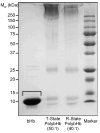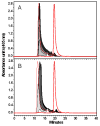Synthesis, biophysical properties and pharmacokinetics of ultrahigh molecular weight tense and relaxed state polymerized bovine hemoglobins
- PMID: 20149433
- PMCID: PMC2837140
- DOI: 10.1016/j.biomaterials.2010.01.072
Synthesis, biophysical properties and pharmacokinetics of ultrahigh molecular weight tense and relaxed state polymerized bovine hemoglobins
Abstract
Hemoglobin-based oxygen carriers (HBOC) are currently being developed as red blood cell (RBC) substitutes for use in transfusion medicine. Despite significant commercial development, late stage clinical results of polymerized hemoglobin (PolyHb) solutions hamper development. We synthesized two types of PolyHbs with ultrahigh molecular weights: tense (T) state PolyHb (M(W)=16.59 MDa and P(50)=41 mmHg) and relaxed (R) state PolyHb (M(W)=26.33 MDa and P(50)=0.66 mmHg). By maintaining Hb in either the T- or R-state during the polymerization reaction, we were able to synthesize ultrahigh molecular weight PolyHbs in distinct quaternary states with no tetrameric Hb, high viscosity, low colloid osmotic pressure and the ability to maintain O(2) dissociation, CO association and NO dioxygenation reactions. The PolyHbs elicited some in vitro RBC aggregation that was less than 6% dextran (500 kDa) but more than 5% human serum albumin. In vitro, T-state PolybHb autoxidized faster than R-state PolybHb as expected from previously reported studies, conversely, when administered to guinea pigs as a 20% exchange transfusion, R-state PolybHb oxidized faster and to a greater extent than T-state PolybHb, suggesting a more complex oxidative processes in vivo. Our findings also demonstrate that T-state PolybHb exhibited a longer circulating half-life, slower clearance and longer systemic exposure time compared to R-state PolybHb.
Copyright 2010 Elsevier Ltd. All rights reserved.
Figures










 ) bHb, (
) bHb, ( ) T-state PolybHb and plasma samples from the end of transfusion to 48 hours (shown as dark grey fading to white). (B) Size exclusion chromatography of (
) T-state PolybHb and plasma samples from the end of transfusion to 48 hours (shown as dark grey fading to white). (B) Size exclusion chromatography of ( ) bHb, (
) bHb, ( ) R-PolybBv and plasma samples from the end of transfusion to 24 hours (shown as dark grey fading to white).
) R-PolybBv and plasma samples from the end of transfusion to 24 hours (shown as dark grey fading to white).
Similar articles
-
Tangential flow filtration facilitated fractionation and PEGylation of low and high-molecular weight polymerized hemoglobins and their biophysical properties.Biotechnol Bioeng. 2022 Jan;119(1):176-186. doi: 10.1002/bit.27962. Epub 2021 Oct 26. Biotechnol Bioeng. 2022. PMID: 34672363 Free PMC article.
-
Tissue oxygenation after exchange transfusion with ultrahigh-molecular-weight tense- and relaxed-state polymerized bovine hemoglobins.Am J Physiol Heart Circ Physiol. 2010 Mar;298(3):H1062-71. doi: 10.1152/ajpheart.01022.2009. Epub 2010 Jan 8. Am J Physiol Heart Circ Physiol. 2010. PMID: 20061539 Free PMC article.
-
Simulation of NO and O2 transport facilitated by polymerized hemoglobin solutions in an arteriole that takes into account wall shear stress-induced NO production.Biophys Chem. 2012 Mar;162:45-60. doi: 10.1016/j.bpc.2011.12.006. Epub 2012 Jan 9. Biophys Chem. 2012. PMID: 22285312 Free PMC article.
-
[Modified hemoglobin solutions as artificial oxygen carriers].Infusionsther Transfusionsmed. 1994 Nov;21 Suppl 3:63-7. Infusionsther Transfusionsmed. 1994. PMID: 7841783 Review. German.
-
Haemoglobin-based erythrocyte transfusion substitutes.Expert Opin Biol Ther. 2001 Sep;1(5):831-43. doi: 10.1517/14712598.1.5.831. Expert Opin Biol Ther. 2001. PMID: 11728218 Review.
Cited by
-
Pilot scale production and characterization of next generation high molecular weight and tense quaternary state polymerized human hemoglobin.Biotechnol Bioeng. 2022 Dec;119(12):3447-3461. doi: 10.1002/bit.28233. Epub 2022 Oct 3. Biotechnol Bioeng. 2022. PMID: 36120842 Free PMC article.
-
Biophysical properties and oxygenation potential of high-molecular-weight glutaraldehyde-polymerized human hemoglobins maintained in the tense and relaxed quaternary states.Tissue Eng Part A. 2011 Apr;17(7-8):927-40. doi: 10.1089/ten.TEA.2010.0353. Epub 2011 Jan 16. Tissue Eng Part A. 2011. PMID: 20979534 Free PMC article.
-
Biophysical properties of tense quaternary state polymerized human hemoglobins bracketed between 500 kDa and 0.2 μm in size.Biotechnol Prog. 2022 Jan;38(1):e3219. doi: 10.1002/btpr.3219. Epub 2021 Oct 14. Biotechnol Prog. 2022. PMID: 34626100 Free PMC article.
-
Scalable production and complete biophysical characterization of poly(ethylene glycol) surface conjugated liposome encapsulated hemoglobin (PEG-LEH).PLoS One. 2022 Jul 8;17(7):e0269939. doi: 10.1371/journal.pone.0269939. eCollection 2022. PLoS One. 2022. PMID: 35802716 Free PMC article.
-
Tangential flow filtration facilitated fractionation and PEGylation of low and high-molecular weight polymerized hemoglobins and their biophysical properties.Biotechnol Bioeng. 2022 Jan;119(1):176-186. doi: 10.1002/bit.27962. Epub 2021 Oct 26. Biotechnol Bioeng. 2022. PMID: 34672363 Free PMC article.
References
-
- Greenburg AG. Benefits and risks of blood transfusion in surgical patients. World J Surg. 1996;20(9):1189–93. - PubMed
-
- Finucane ML, Slovic P, Mertz CK. Public perception of the risk of blood transfusion. Transfusion. 2000;40(8):1017–22. - PubMed
-
- Busch MP, Kleinman SH, Nemo GJ. Current and emerging infectious risks of blood transfusions. JAMA. 2003;289(8):959–62. - PubMed
-
- Stramer SL. Current risks of transfusion-transmitted agents - A review. Arch Pathol Lab Med. 2007;131(5):702–7. - PubMed
Publication types
MeSH terms
Substances
Grants and funding
LinkOut - more resources
Full Text Sources
Research Materials

